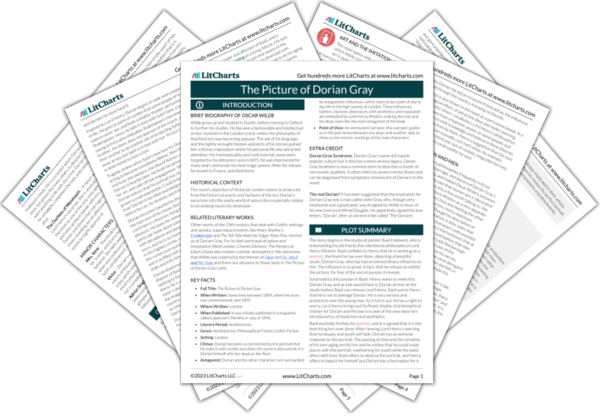Summary
Analysis
A week later, Dorian is entertaining the Duchess, her husband, and other elegant guests at his country house. Dorian, the Duchess, and Lord Henry discuss Henry’s plan to “rechristen” everything - he thinks that no one gives beautiful names to things anymore. Henry and the Duchess trade quips, their wits on equal footing. The Duchess accuses him of valuing beauty too highly. Henry disagrees. He also values ugliness, he claims.
Lord Henry’s preoccupation with names instead of the substance of things shows off his superficial outlook. As always, he uses his language and logic exquisitely, impressing everybody, but the Duchess’s equal linguistic acrobatics threatens his status in the group, and everything he preaches about women and genius.
Themes
Quiz
Test Yourself
They banter back and forth, on the virtues of the English, on the meaning of love, the importance of reputation. The Duchess makes the point that women love with their ears, while men love with their eyes, and accuses Dorian of never really loving. Henry responds that he believes that there are very few good experiences, and that one must live a life of repetition in order to be happy. He insinuates that Dorian’s many romances should not put her off. Dorian tells the Duchess that he agrees with Henry, but that he does not desire happiness, only pleasure.
The pair seem to go through many topics in their discussion ranging from race to romance, but if we look carefully, all these subjects are but appearances and rumors. Though Henry’s words are hypnotic, his arguments beautifully structured, beneath them lies a troubling promotion of addictive, superficial and unsustainable behavior. Dorian’s acceptance of the beautiful surface of Henry’s arguments shows the brain-washed state Henry has him in.
Themes
Quiz
Test Yourself
Dorian goes to fetch some orchids for the Duchess to take home. When he is gone, Henry inquires about the Duchess’s flirting. She likes the challenge of Dorian. Henry warns that Lady Narborough is also after him. They discuss tactics, using similes from the myths of romance and war, Henry mocking the female cause but the Duchess defending it as the source of all romance. But they are interrupted – Dorian has collapsed in the other room.
Marriage, companionship and meaningful love are degraded by the characters’ infidelity and lack of care. While it is someone like Henry who is on an intellectual level with the Duchess, the attention of all the women goes towards the object, Dorian. War imagery turns Dorian into a figurehead, a prize, and reminds us of when he was a muse for Basil. War and Art actually seem to be similarly destructive.
Themes
Quiz
Test Yourself
Dorian is put on a sofa and comes round, realizing where he is. Henry assures him he only fainted, and Dorian insists on dressing and eating with his guests. As he dresses he remembers that it was the sight of James Vane’s face at the window that had caused him to faint, and terror fills his heart.
Dorian has faced the horrors of his actions and past. But in James Vane he suddenly faces the prospect of his death, and he can't handle it. He responds to his fear by keeping up appearances.
Themes
Quiz
Test Yourself
Get the entire The Picture of Dorian Gray LitChart as a printable PDF.













